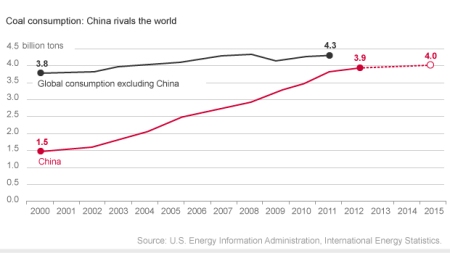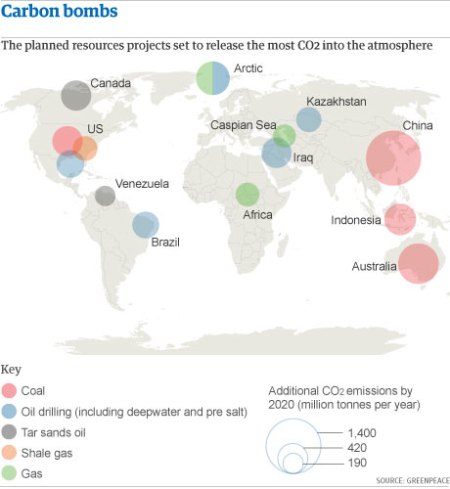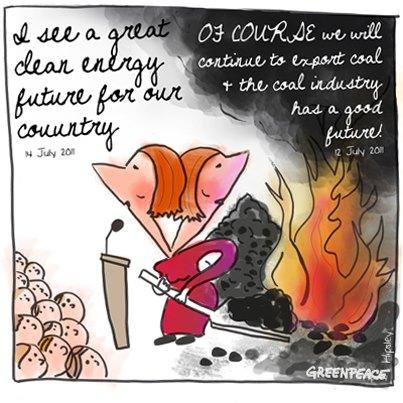Posts Tagged ‘Global Warming’
 19 February 2013
19 February 2013
The Greens have publicly distanced themselves from the Labor government in the leadup to the Australian federal election on 14 September.
Last month, Labor Prime Minister Julia Gillard and Liberal leader Tony Abbott each launched their party’s election campaign with a National Press Club speech. (Gillard discussed economic policy, hinted at more budget cuts, and announced the election date; Abbott reiterated past promises including a budget surplus.) Today, Greens leader Christine Milne similarly addressed the National Press Club. In a strong speech, Milne argued Labor has flouted the principles it agreed with the Greens in 2010: “transparency and accountable government”, “policies which promote the public interest”, and “policies which address climate change”.
The move is long overdue. As I’ve written before, the Greens’ support has given credibility to a government which has gotten away with: Read the rest of this entry ?
Posted in Climate, Climate Politics, News, Politics, Strategy | Tagged Australia, Australian Greens, Carbon Tax, Christine Milne, Climate Change, Democracy, Energy, Environment, Fossil Fuels, Global Warming, Julia Gillard, News, Politics, Thoughts | Leave a Comment »
 13 February 2013
13 February 2013
Australian Environment Minister Tony Burke – or as the Greens call him, Minister Against the Environment – on Monday signed conditional approvals for three new coal and coal seam gas (CSG) mines in New South Wales.
The three projects are Whitehaven’s Maules Creek coal mine (despite Burke having said last week he would defer that decision for months), Idemitsu’s Boggabri coal mine expansion, and AGL’s 110 CSG wells in Gloucester (the first stage of a potential 330-well project). Together, they would result in 47 million tonnes of CO2 emissions per year. (To make matters worse, on the same day the NSW state government gave conditional approval to BHP Billiton’s Dendrobium coal mine expansion, and on Tuesday the Queensland government lifted a moratorium on shale oil.)
Burke says his decision is intended to cut the NSW government out of the process, after NSW Resources Minister Chris Hartcher leaked a confidential letter from Burke expressing an intention to approve the three projects. Burke claims his new approvals come with unusually stringent conditions:
For the areas that are not yet resolved, instead of giving a normal approval and say these are the conditions, I’ve said these further issues need to be worked through to my satisfaction before we know whether the project can actually go ahead. So it’s quite – even though it’s just being reported as approvals, it’s actually quite a different set of conditions to what would normally occur. Read the rest of this entry ?
Posted in Climate, Climate Politics, Energy, Greenwash, News, Politics | Tagged Australia, Australian Labor Party, Climate Change, Coal, Coal Seam Gas, Energy, Environment, Fossil Fuels, Gas, Global Warming, News, Politics, Tony Burke | 2 Comments »
 7 February 2013
7 February 2013
Last week China announced what might be a rare bit of good news on climate change – or is it too good to be true?
The Chinese government State Council has set a cap on total energy use for 2011-2015, which it claims will cause Chinese coal consumption to peak below 4 billion tonnes per year, a target that has been rumored for a while. According to the Chinese government, coal-fired electricity generation would continue to grow at a slower pace while the steel industry would suffer.
Last year China burned 3.9 billion tonnes of coal, a 163% increase since 2000 and nearly as much as the rest of the world combined. Greenpeace recently identified the projected expansion of coal mining in northwestern Chinese provinces as the world’s largest “carbon bomb” (followed by Australian coal export expansion).
 Read the rest of this entry ?
Read the rest of this entry ?
Posted in Climate, Climate Politics, Energy, News, Politics | Tagged Australia, China, Climate Change, Coal, Energy, Environment, Global Warming, News, Politics, Renewables | 2 Comments »
 4 February 2013
4 February 2013
Republican strategist Karl Rove in 2002 notoriously disparaged “the reality-based community [who] believe that solutions emerge from your judicious study of discernible reality”. He continued: “That’s not the way the world really works anymore. We’re an empire now, and when we act, we create our own reality. And while you’re studying that reality—judiciously, as you will—we’ll act again, creating other new realities, which you can study too, and that’s how things will sort out. We’re history’s actors…and you, all of you, will be left to just study what we do.”
That quote has become a symbol for the Republican Party’s detachment from empirical reality, like Mitt Romney’s recent declaration “we’re not going to let our campaign be dictated by fact checkers”. I’m a proud member of the “reality-based community”, in that I try to base my views as much as possible on observed facts rather than instinct or ideology. Yet Rove understood something his political opponents don’t: “political reality” is an illusion.
Campaigners who pride themselves on being “political realists”, and voters who pride themselves on being “centrists”, make the fundamental mistake of assuming the political centre is a real thing fixed in one position. Although political scholars talk about an objective centre halfway between the most extreme possible ideological orientations, it has no influence on political debate. In practice, the political centre is a perception that can be manipulated by various political forces. Thus it is possible to shift the political centre, or “political reality”, without deluding as the Republicans do – you only need to change the perception of where the centre is.
Here’s another way of looking at it. The “Overton window” is the range of political positions considered to be the scope of reasonable debate. The perceived political centre is in the middle of the Overton window. Positions toward the edges of the Overton window are considered radical, and positions beyond the edges are considered unthinkable.
A third way of conceptualizing this is “Hallin’s spheres”, three nested ideological spheres illustrating the implicit bias of ostensibly objective media coverage. In the centre is the “sphere of consensus”, consisting of propositions considered by the journalist (or other observer) to be self-evident to all reasonable people. The intermediate shell is the “sphere of legitimate controversy”, matters considered suitable to be debated among reasonable people; journalists generally strive for balanced coverage of the views in this shell. The outer shell is the “sphere of deviance”, positions considered to be outside the range of mainstream debate. In this metaphor it is journalists who (consciously or otherwise) decide which ideas belong in which sphere, and they tend to make those decisions based on the thinking of the political establishment. Read the rest of this entry ?
Posted in Climate, Climate Politics, Greenwash, Media, Politics, Strategy | Tagged Activism, Centrism, Climate Change, Communication, Corporate Lobbying, Democracy, Denialism, Framing, Global Warming, Journalism, Media Criticism, Political Reality, Politics, Random, Thoughts | Leave a Comment »
 24 January 2013
24 January 2013
A new report by consultancy Ecofys for Greenpeace, called Point of No Return, details 14 proposed fossil fuel projects, dubbed “carbon bombs”, that would together effectively lock in dangerous climate change.

If the 14 projects go ahead, they would add 6.3 Gt/year (greater than present US emissions) to global CO2 emissions in 2020, a 20% increase at a time when we urgently need to cut global emissions as fast as possible. They would add 300 Gt CO2 to the atmosphere by 2050, about a third of the carbon budget for 2010-2050 required for a 75% chance of avoiding 2°C of global warming, the level which the world’s governments have agreed to prevent. They would keep us on the business-as-usual pathway that leads to an unimaginably catastrophic 6°C by 2100. Thus it is imperative that these fossil fuels be left in the ground. Read the rest of this entry ?
Posted in Climate, Climate Politics, Energy, News, Politics | Tagged Australia, Carbon Budget, China, Climate Change, Climate Crisis, Coal, Energy, Environment, Fossil Fuel Exports, Fossil Fuels, Gas, Global Warming, Greenpeace, News, Politics | 1 Comment »
 19 January 2013
19 January 2013

As Australia bakes in record-breaking heat and burns in devastating fires, the country’s political and media elites have yet again lined up to defend the industry driving global warming and cast those who speak out against it as extremists. Read the rest of this entry ?
Posted in Climate, Climate Politics, Energy, News, Politics, Solutions, Strategy | Tagged Activism, Australia, Climate Change, Climate Crisis, Coal, coal exports, Energy, Environment, Fossil Fuel Exports, Fossil Fuels, Global Warming, News, Politics, Protest, Thoughts | 1 Comment »
 16 January 2013
16 January 2013
This is the third part of a series examining the Liberal Party of Australia. Part 1 covers the party’s climate change denial and intention to abolish various existing climate policies. Part 2 examines the climate policies they promise to introduce. This part defends them against incorrect criticisms of their climate policies.
To use language which Liberal leader Tony Abbott might outside of a family program, the Liberals’ climate policy is complete crap. Having said that, its problems do not include some of the things for which it is most often criticized: fiscal impact, directness, and reliance on domestic action.
Fiscal impact
Some commentators (eg. Alan Kohler) claim the Liberals’ policy would have a massive impact on the government’s budget. But there is nothing wrong with the government spending money on addressing the greatest threat facing humanity. Indeed, we should be spending far more than either major party is currently prepared to. The real problem, as I explained in Part 2, is the Liberals would not spend enough. The Emissions Reduction Fund is capped at $10.5 billion by 2020, making it impossible to make sure it meets its target (let alone a more ambitious target). Because the Fund’s current costings depend on achieving 60% of its abatement through buying soil carbon offsets, it is difficult to see how it could make genuine absolute emissions cuts with such a limited budget. Read the rest of this entry ?
Posted in Carbon Price, Clean Energy Future, Climate, Climate Politics, Politics, Spin | Tagged Australia, Australian Industry Greenhouse Network, Australian Labor Party, Budget, Carbon Tax, Climate Change, Direct Action Plan, Emissions Trading, Environment, Global Warming, Liberal Party of Australia, Offsets, Ross Garnaut, Thoughts, Tony Abbott | Leave a Comment »
 13 January 2013
13 January 2013
This is the second part of a series examining the Liberal Party of Australia. Part 1 covers the party’s climate change denial and intention to abolish various existing climate policies. This part examines the climate policies they promise to introduce.
The first question to ask about the Liberal Party’s climate policy is “what is it?” This question is a lot more difficult to answer than you might think. One of the reasons why I have not focused on the Liberals is because although they are aggressive on process, their policies are vague if not contradictory. If they weren’t favored by nearly half of Australian voters, I would say the Liberals are the parliamentary clowns. Nevertheless, I will examine the few details they have provided.
The Liberals propose a set of measures they spin as a “Direct Action Plan”, a frame that has been uncritically adopted by many journalists. While the phrase “direct action” brings to mind images of protestors chained to bulldozers, the content of the Direct Action Plan is rather less exciting, neither particularly direct nor very active.
The plan is mainly articulated in a policy document released before the last election (all quotes below are taken from this document unless otherwise attributed). It is unclear how current this document is: it is nearly three years old so the timeline will obviously need to be condensed to meet the 2020 deadline, and the Liberals have since mentioned various revisions and reinterpretations, some of which I may have missed. Presumably a full updated policy will be released before the next election; in the meantime I have assumed the old document is accurate except where I am aware of later changes.
The plan is supposed to directly cut CO2 emissions 5% below 1990 by 2020, very similar to Labor’s meaningless target (with the positive difference that the Liberals would not use international offsets, a point I will come back to in Part 3). The Liberals also ostensibly support Labor’s conditional target range of 5-25%, though they have not mentioned it for a long time. Indeed, they rubbish their own 5% target. Liberal leader Tony Abbott has described it as “crazy” in the context of China’s increasing emissions. On other occasions Abbott has gone even further (which a leaked list of talking points shows was scripted), claiming the target will not reduce global temperature for 1000 years (missing that the point of climate action is to limit the rise of global temperature). The Liberals can’t have it both ways: is a 5% target insignificant or Liberal policy? Read the rest of this entry ?
Posted in Climate, Climate Politics, Energy, Greenwash, Politics, UN Climate Talks | Tagged Australia, Baseline-And-Credit, Climate Change, Denialism, Direct Action Plan, Electricity, Energy, Environment, Global Warming, Greg Hunt, Liberal Party of Australia, Politics, Renewables, Tony Abbott, UNFCCC | 2 Comments »
 11 January 2013
11 January 2013
Almost all of my posts to date have focused on criticizing Australia’s incumbent Labor government. I have written very little about the alternate Liberal/National Coalition government. But as we enter an election year, it is time to examine the Liberals’ policies.
Can the Liberals be trusted?
To begin with, it is worth noting that the Liberals have given us every reason to distrust them on climate change.
According to a 2010 survey, only 38% of Coalition politicians accept that humans are warming the planet (compared to 98% of Greens, in line with the scientific consensus, and 89% of Labor politicians). Liberal and National politicians regularly spout denialist talking points, up to and including their leader Tony Abbott. Most notoriously, Abbott reportedly said in 2009 that the science of climate change is “complete crap” but “the politics of this are tough for us”. In 2010 Abbott met with Christopher Monckton, a man who claims climate scientists are conspiring to fake their results in a plot to create a socialist world government. In a speech to the Mining Council of Australia in 2011, Abbott said “the authors of the carbon tax do not see coal, oil and gas as the most important parts of our economy” but “as a threat to the very survival of our planet”, the obvious implication being that his party disagrees. In 2011 former Liberal Prime Minister John Howard launched a book instructing schoolchildren to raise denialist arguments in the classroom. Queensland’s Liberal National government wants to remove climate from the school curriculum, and its Premier and Environment Minister openly deny human-caused global warming.
I could list many more examples. Indeed, it would probably be quicker to list Coalition politicians who have never publically made denialist claims.
Almost all of the Liberals’ actions mark them as an anti-climate party. The Liberals did not take any significant climate action during the eleven years of the Howard government. They consistently prioritize short-term economic considerations like mining industry competitiveness and electricity prices ahead of climate change. Today they are putting way more effort into opposing Labor’s climate policy than in designing and promoting their own (the former is the subject of this post; the latter will be covered in Part 2). Thus it is questionable whether they would even implement their climate policy, let alone whether it would work. Read the rest of this entry ?
Posted in Carbon Price, Clean Energy Future, Climate, Climate Politics, Denialism, Deregulation, Politics, Renewable Energy Target | Tagged Andrew Robb, Australia, Carbon Tax, Clean Energy Finance Corporation, Climate Change, Climate Change Authority, Denialism, Deregulation, Emissions Trading, Environment, Global Warming, Liberal Party of Australia, Politics, Renewable Energy Target, Tony Abbott | 3 Comments »
 31 December 2012
31 December 2012
The Guardian described 2006 as “The year the world woke up” to climate change. If that’s the case then I guess 2007 was the year we rolled over and went back to sleep. Our alarm clock has continued to ring ever more loudly and clearly, but we just keep on hitting the snooze button – if we even hear the alarm at all. The events of 2012 have continued the pattern, both in Australia and around the world.
January
A diverse group of organizations warned there is a “carbon bubble” in global financial markets. Yawn… oh look, Novak Djokovic won the Australian Open!
February
Mining magnate and climate change denier Gina Rinehart tried to take over an Australian newspaper chain. Business news is so dreary… wow, congratulations to Queen Elizabeth II for reaching her Diamond Jubilee!
Australian ex-PM Kevin Rudd attempted to regain the top job and lock in a meaningless greenhouse gas emissions target. Hey, someone leaked a video of him saying the F-word!
March
Greenpeace exposed Australia’s plans to multiply its already-world-beating coal exports on a scale dwarfing its emissions at home, to which the government responded by passionately defending the industry. Soporific stuff… look, Clive Palmer is fighting with his soccer team!
Australia introduced a tax on coal mining profits that failed to raise any revenue. How dull… whoa, Sachin Tendulkar scored his 100th international century in cricket! Read the rest of this entry ?
Posted in Climate, Climate Politics, Climate Science, News, Satire | Tagged 2012, Climate Change, Climate Crisis, Denialism, Environment, Global Warming, History, Humor, Journalism, Media Criticism, News, Politics, Public Ignorance, Random, Year In Review | 3 Comments »



